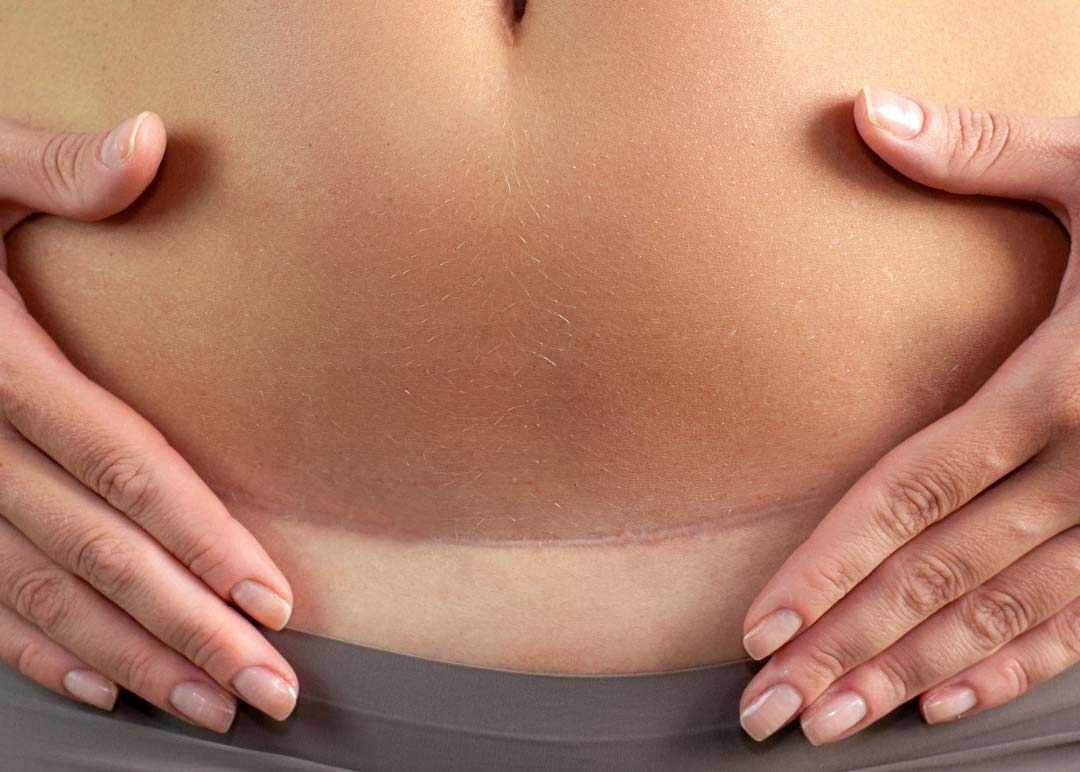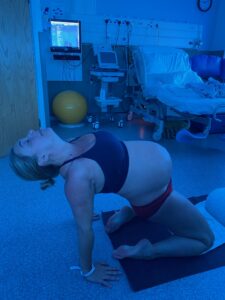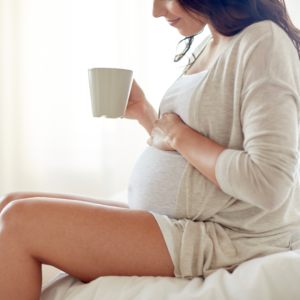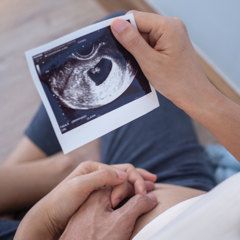Your Birth Options after previous Caesarean
If your last birth was by caesarean & you’re pregnant again, you’re pretty likely to have heard the term VBAC, or vaginal birth after caesarean. It’s one of the birth options discussed with you along with elective repeat caesarean (ERCS).
In the UK you will be offered a VBAC clinic appointment around 28 weeks to discuss these options. It’s an entirely personal choice and will be very dependent on your previous birth experience. This appointment is a great opportunity to explore your preferences surrounding either method with a senior obstetrician or consultant midwife.
The Risks and Benefits of Vaginal Birth
The main risk associated with a VBAC, which will be discussed with you is uterine rupture (0.5%). I generally use the analogy of balloon with a thinner area (which would represent the scar). If we inflate the balloon and then repeatedly squeeze it, which is essentially what your contractions represent, at some point it may pop! There is a significant blood supply to your uterus (around half a litre a minute flows there). If your uterus ‘pops’ you can suddenly loose a lot of blood and your baby will compromised too. We therefore monitor your baby continuously in labour.
Now all of this can sound pretty scary as a concept and it’s important to be aware of, but also you should feel reassured that your healthcare providers are trained to look for signs that this complication may be developing. Continuous monitoring is a universal precaution because it is the thing above all else that will alert us. There are several other features which can be indicative of a uterine rupture, but any changes in your baby’s heart rate, which may indicate your scar is becoming compromised will mean that your delivery will be expedited.
This means that in real terms that although we quote a risk of rupture of 1 in 200 births, the neonatal morbidity and mortality rates are comparable to first time mothers.
The majority (90%) of scar rupture happens in labour and the most frequent dilatation that this is seen at around 4-5cm, with the chance of a rupture happening prior to labour is extremely rare (0.02%).
If you choose to have a VBAC it can be helpful to know your likelihood of success, we broadly quote the chance of you having a normal delivery at around 72-75% (meaning 25% chance of an emergency caesarean). These are just general rates and it’s really important to have an individualised discussion with your healthcare providers, based around your individual circumstances. Whether you labored previously, the reason for your last caesarean and whether you labour spontaneously in this pregnancy, are all factors which will significantly affect your chances. For example If you’ve previously had a vaginal delivery the chance of a successful VBAC goes up to 90%.
The other risks that will be discussed with you are those associated with any woman having a vaginal birth regardless of whether it’s a VBAC. These will include:
- Perineal tear/pelvic floor injury (90% of women have some kind of vaginal trauma be it a graze or a more significant tear. The chances of a significant tear affecting your anal sphincter is around (6% for first vaginal birth)
- Instrumental delivery, this is a forceps or suction cup (ventouse) birth (up to 30% for first vaginal birth)
- Major blood loss (1-3%), see above for what this means.
- Benefits would be shorter hospital stay & recovery & avoiding a big surgery.
Factors increasing the success of VBAC
If you are planning on having a VBAC, there are certain things that increase your chance of success, some of which are unfortunately not modifiable, but it can be helpful to know if you’re still undecided and want to consider your likelihood of a vaginal birth. Having or not having any of these features is not absolute though and as with all of the information, it’s here to empower you to make your own informed decision.
- Having a previous vaginal birth is the single biggest predicting factor of having a successful VBAC and your chances are around 85-90% if this will not be your first vaginal birth.
- If you’re under the age of 40 you have a slightly higher chance of having a successful VBAC than women over this age, this is most likely due to collagen becoming less elastic as we get older, leading to our body’s being less adaptable to the birthing process.
- Weight does play a factor on how your body labours and we know that risks are slightly increased in terms of requiring an emergency caesarean with women who are obese, which is classed when your body mass index (BMI) is greater than 30. The chance of an emergency caesarean is 8% compared to 17.2% in women of higher BMI.
- Bigger baby – if your baby has an estimated fetal weight of >4kg your risk of rupture increases to 3.6% and chances of successful VBAC drops to around 50%. Again it’s important to remember that EFW is not an accurate science. This is is an estimation based on a scan with an at least 10% margin on either side.
- Going in to spontaneous labour – as you can imagine, if your body is ready to labour and does so spontaneously, this will increase your chances of a VBAC.
- Having your baby before 40 weeks increases your chances of having a successful VBAC. This is likely to be related to the size of your baby before this (see above for Big Babies)
What if I go past my due date?
As mentioned above one of the factors contributing to chances of success is having your baby before your due date. We know that there is a slight increased risk in still birth in women who have had a previous caesarean, which will increase beyond 40 weeks. This is not hugely significant until you reach the 41 week mark. Different obstetric units, may therefore have different policies in terms of timing of recommended delivery in women wanting a VBAC.
The National Institute of Clinical Excellence (NICE) advises Induction of Labour (IOL) at 41 weeks for women without a previous scar, stating that it reduces perinatal mortality without increasing risk of emergency caesarean. This is difficult to extrapolate for women having a VBAC as additional risk factors exist. It’s therefore important to say that increased IOL risk needs to be balanced with an increased risk of still birth, which is quoted as 0.05% in women over 39 weeks, compared with 0.11% in women with a previous scar, which is a 1.5-2 time increase in absolute risk.
We can compare this to the risks associated with induction of labour for women with a previous scar on their uterus, which has an increased absolute risk of scar rupture of 2-3 times and will increase your chance of having an emergency caesarean by 1.5 times.
Its also worth noting that the process may slightly different for IOL if you are having a VBAC. A catheter balloon, called a Cook’s Balloon, rather than prostaglandin pessary or gel is normally used in the cervical ripening stage as a more gentle method of cervical ripening (stage 1), once your waters have been broken (stage 2), some time would be given before starting a cautious trial of the synthetic oxytocin drip (stage 3), due to an increased risk (x4) of uterine rupture when using high doses. In clinics when I see women earlier on in pregnancy I therefore discuss the option of having a cervical sweep from 37 weeks of pregnancy to optimise your chances of going in to labour by 40 weeks.
What is a cervical sweep?
A cervical sweep is an examination of your cervix, to make an assessment of it’s favourability for labour. If your cervix is soft or open enough, we may be able to insert a finger and gently perform a sweeping action inside the uterus to stretch the cervix and sweep the membranes surrounding your baby from the wall of the uterus, causing your body to release natural prostaglandins, a natural chemical messenger that helps your uterus get ready for birth. This can be a pretty uncomfortable examination and may not be the right thing for everyone, but it’s worth considering as an option to help you get in to labour on your own. If you do elect to have this, having several every week (24-48 hours apart) until your due date, will increase your chances of going in to labour.
Yoga can also be a really fantastic tool to use in your pregnancy to stay mobile and as you approach your due date it can be incredibly beneficial in helping ease your body towards the process. Have a look at my YouTube channel for a great video you can try prepare your body for birth.
Having a Repeat Caesarean Section
If you plan to have an elective repeat caesarean section, know that this decision is a completely valid one. You may have had a particularly traumatic birth or postnatal period with your last baby, or perhaps you just don’t want to have a repeat performance of being in labour for a long time and potentially ending up with a caesarean again. Once you’ve processed the information during your VBAC appointment, this will be a choice which is your alone and you should be supported in whatever choice you make.
An ERCS routinely takes place at 39 weeks, to balance the risk of prematurity with that of you going in to labour spontaneously and needing a more rushed and unplanned caesarean. Your obstetrician will counsel you about the main risks, which are broadly this same as the first time round and include:
- Significant blood loss (3-5%) – we expect you to bleed a certain amount, around 500ml is average. By significant we mean enough to cause compromise to you, potentially requiring a blood transfusion. There are many things that can be done to stop bleeding, such as medications and procedures.
- In very uncommon scenarios (0.7-0.8%), where bleeding cannot be stopped and there’s a risk to your life, a life-saving hysterectomy may be performed as a last resort. You would be told before this happens.
- Damage to organs that are nearby the uterus, like bowel or bladder (0.2%) – if damaged these would be repaired at the same time
- Injury to your baby (sometimes there can be a small cut on baby’s head 2% or initial difficulty in breathing 5%, which is normally transient lasting for about 24 hours).
- An infection of the bladder or wound post operatively can be up to 12%, you are normally given antibiotics at the start of surgery to reduce this risk. More serious pelvic infections are less common
- Blood clot to your leg or lung (Deep vein thrombosis or pulmonary embolism) These are rare (4-16 in 10,000) but because have life threatening complications, you will be recommended to take blood thinning injections for at least 10 days after birth, to reduce this risk. You can also help by staying well hydrated and mobilising as soon as you’re able to.
- Having another caesarean also has implications on your future pregnancies. Ultimately this is major surgery so recovery will be longer than following a straightforward vaginal birth.
The obvious benefit of having a planned birth by caesarean is that you have more control. You will avoid the risks associated with a vaginal birth & have a planned date for the birth of your baby, all of which can be really important. You also virtually avoid the risk of a scar rupture.
It’s important to know that an ERCS can be a really positive birth and your team can do things to optimise this experience. Here are some ways to help facilitate this experience:
- Your Birth Partner will be able to be with you during the caesarean
- Asking for the drapes to be dropped, to see the birth of your baby
- Keeping the sex of your baby a surprise and for you to be the first people to state what it is
- Consider having music that is personal to you (this is always a favourite of mine and makes the experience lovely for everyone).
- Delayed cord clamping – so long as there is no significant bleeding and your baby is well, this is something we normally do as standard these days.
- Early skin to skin – This is really valuable, sometimes you can feel a little sick or claustrophobic, but it’s definitely something worth giving a go and your midwife will be able to help facilitate this.
I often see women during a VBAC clinic, some may have had a caesarean in their last pregnancy and are desperate to try for a vaginal birth, others may still feel very traumatised from a previous emergency delivery and ask for an ERCS. It’s important to remember there’s no ‘right’ decision. Whatever you decide will be a very personal one and finding a way to have a positive birth experience, whatever that looks like for you is the most important thing.
References
Royal College of Obstetricians and Gynaecologists, Birth After Caesarean Section, Green-Top Guideline No 45, London, RCOG
https://www.rcog.org.uk/globalassets/documents/guidelines/gtg_45.pdf
Royal College of Obstetricians and Gynaecologists, Consent Advice Caesarean Section, No 7
https://www.rcog.org.uk/en/guidelines-research-services/guidelines/consent-advice-7/





